Is the new 597bhp Ferrari 458 Speciale set to be the ultimate V8 supercar? Ben Pulman headed to Ferrari’s Maranello headquarters to see for himself…
Ferrari’s Formula One team might be struggling to put Alonso on the podium, but its road-car division keeps hitting new highs: the F12 is a masterpiece, its 950bhp LaFerrari is poised to eclipse the legendary Enzo, and now this new hardcore version of the 458 Italia will cause sleepless nights down the road in Sant’Agata where Lamborghini is readying its Gallardo replacement.

Called the 458 Speciale, it follows the template set by the 360 Challenge Stradale and 430 Scuderia as a more extreme iteration of Ferrari’s contemporary V8 sports car. Power is up, weight is down, but there’s also new active aerodynamics that will feature on all future Ferraris, clever lightweight technologies shared with LaFerrari, and even some trick chassis electronics that you won’t find on that £1m hybrid hypercar. With the regular 458 Italia still the supercar benchmark four years after launch, this new and improved 458 Speciale might just be the greatest Ferrari ever made…

The heart of every Ferrari is a high-revving, naturally aspirated engine, and the Speciale’s promises to be pretty, err, special. It’s the same 4.5-litre V8 you’ll find in the 458 Italia, but with shorter inlet tracts, higher-lift cams, lighter pistons and a new crankshaft. The intake plenums and filter box are made from carbonfibre, the exhaust has been upgraded too. The result is 597bhp at a stratospheric 9000rpm.

It’s a mere 34bhp more than the Italia (and the 398lb ft peak at 6000rpm is identical, though there’s more torque at low and medium revs) yet this was never a lazy engine. It may not be the world’s most powerful naturally aspirated V8 – the 622bhp 6.2-litre in the Merc SLS Black Series holds that honour – but 597bhp makes it the most powerful naturally aspirated Ferrari V8 ever. And with 597bhp coming from just 4497cc, the Speciale’s 133bhp-per-litre means it has the highest specific output of any naturally aspirated Ferrari road car, Enzo and LaFerrari included.
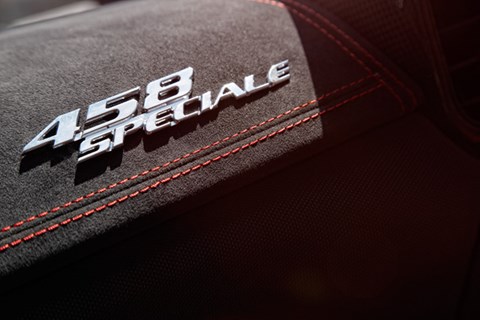
The 0-62mph sprint is down from the Italia’s ‘sub-3.4sec’ to 3.0sec, but a better marker is the 0-124mph time of 9.1 seconds, 1.3sec faster than the standard 458 and Lamborghini’s Speciale rival, the Gallardo Superleggera. The Fiorano lap time has tumbled too, to 1min 23.5sec, 1.5sec quicker than the Italia, the 430 Scuderia and the iconic Enzo.

Yet Ferrari’s technical director Roberto Fedeli seems almost blasé about the performance gains when we meet in Maranello: ‘We have the Fiorano lap times, the Nürburgring lap times [simulations show a “significant improvement” over the 458 Italia’s 7min 28sec] and the acceleration figures, but they are part of the DNA of our cars. The most important achievement is the feeling of performance: the numbers explain 90%, but it’s the final 10% where we have really added value and that you only experience when driving the car.’
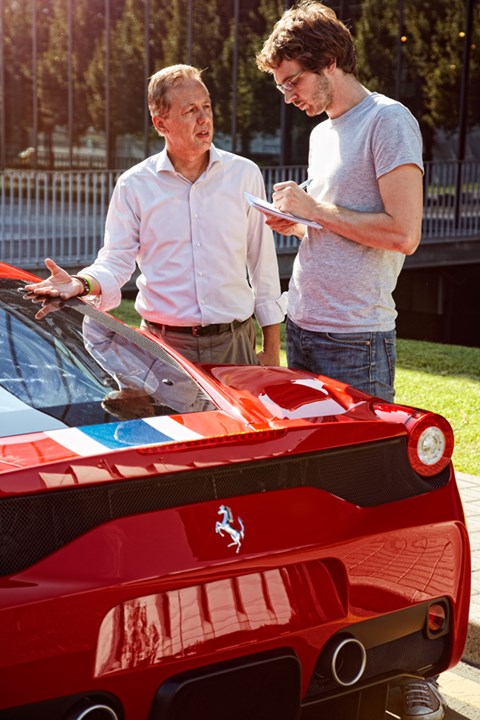
‘The link between what the driver is thinking and what the car is doing must be as quick as possible – the steering, the paddles, the throttle, the brakes, there must be immediate connectivity. The car must react and the driver must feel the reaction. It is our philosophy for extreme sporty cars, and because I’m an engineer it’s a science of numbers, but those numbers must transfer into real feeling. The Speciale is at the same level as LaFerrari, the responses are so close.’
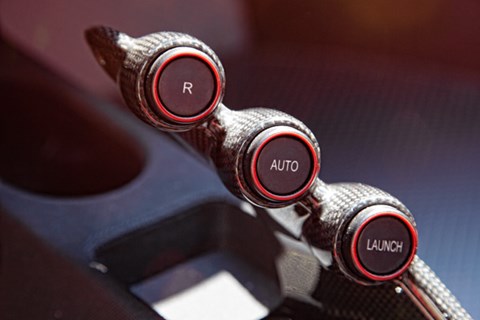
Which is where the Speciale’s other upgrades come in. Take the gearbox: the shifts aren’t any faster, because with the dual-clutch transmission there’s already no interruption of the torque flow to the rear wheels, but reaction times have been reduced, so the gap between you pulling the carbon upshift paddle and feeling the car react is down 40%. And thanks to new SCM-E magnetorheological dampers that adjust every millisecond, Ferrari claims the Speciale has 5% less roll, responds 11% quicker, and you need 14% fewer steering inputs. Numbers galore, but Fedeli insists all the figures deliver a more involving driving experience.
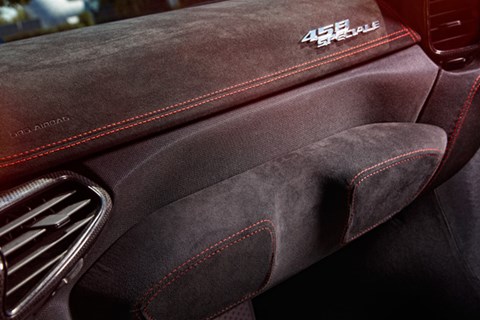
A drastic diet helps too: the difference between an Italia and the new Speciale is 130kg, a near-10% reduction on an already lightweight aluminium sports car. ‘It was the most difficult part of the project,’ reckons Fedeli. ‘When we developed the 458 we made the weight as low as possible, so we had to do a lot to reduce the weight on the Speciale.’
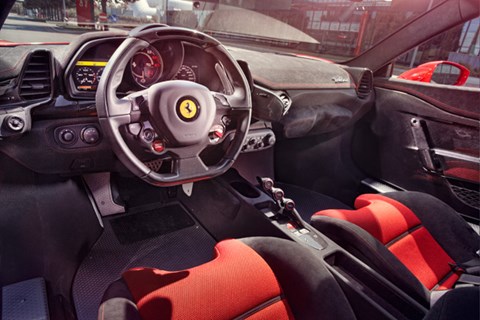
Inside the cabin there’s no trim on the doors, just bare carbonfibre panels, and no carpet, just exposed alloy. The radio and sat-nav have been removed, there are carbonfibre Sabelt seats with four-point harnesses, the same carbonfibre central gearbox stalk you’ll find in LaFerrari, and in place of the glovebox there are kneepads for your passenger to brace against. The stripped cabin accounts for 40% of the Speciale’s weight savings, the other 60% down to many of the Italia’s existing components having been redesigned – composite bumpers, thinner glass for the windscreen and side windows, and the rear screen is Lexan, which is 30% lighter than glass.
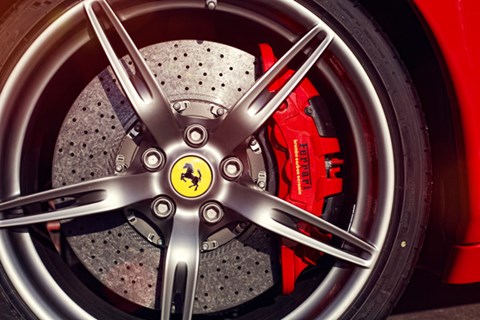
The 20-inch forged wheels weigh 12% less, cutting crucial unsprung weight, plus the brakes are 10kg lighter, and similar to those used on LaFerrari. ‘If we’d kept the Italia’s brake technology but wanted the performance we have on the Speciale, the system would have weighed 30% more,’ explains Fedeli. ‘But we have a new generation of discs with a higher silicon content, hybrid pads from Brembo, plus new calipers, which are smaller and lighter, but cool in a veryefficient way so we can take 30-40% more thermal energy into the system and still dissipate the heat. You’ll see the technology in our next models.’ Stopping distances are down 8%, partly helped by new Michelin Pilot Sport Cup 2 tyres that increase grip by 6%.
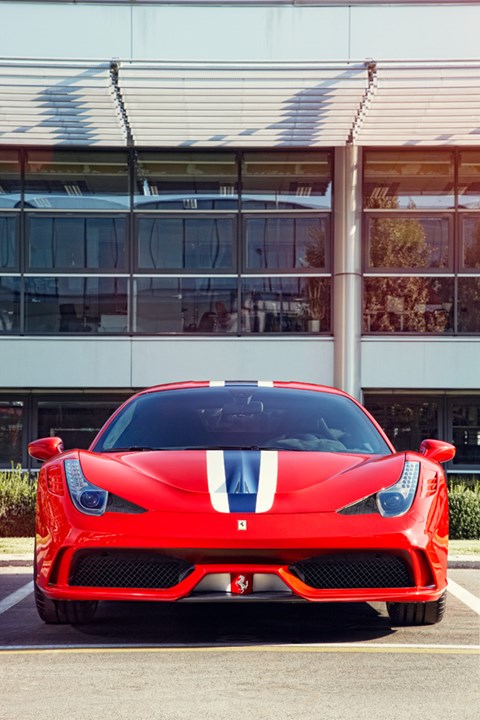
There are clever active aerodynamic aids too, designed to reduce drag when the Speciale is running at high speed. The Italia’s deformable Inspector Clouseau ‘moustache’ front winglets are gone, replaced by two different aero devices in the nose. The first are twin central vanes located either side of the Prancing Horse badge, and air pressure forces them open above 170km/h (106mph) reducing the airflow into the radiators. This cuts drag, but also directs airflow through the vents on the outer edges of the front bumper and along the sides of the Speciale, to vertical winglets in the sills that help balance the aerodynamic loads.
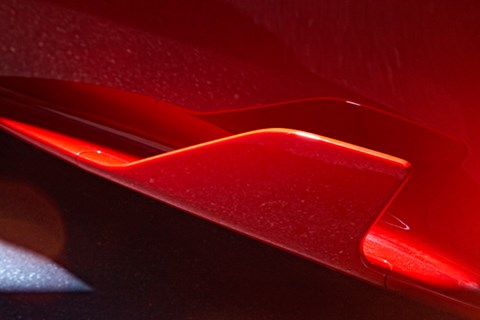
The second aero aid is a horizontal flap located at the leading edge of the front splitter. Again air pressure forces it open, this time above 220km/h (138mph), and it directs more airflow beneath the car, shifting 20% of the aerodynamic load back over the rear axle. ‘I had no doubt it would work,’ laughs Fedeli. ‘The first time I saw it for real was nine months ago at our test track, where we were running the Speciale at night without disguise. We had a camera on the front of the car, and luminous paint on the bumpers – it’s always a good feeling when what you’ve seen in your head and in computer simulations works on the road.’
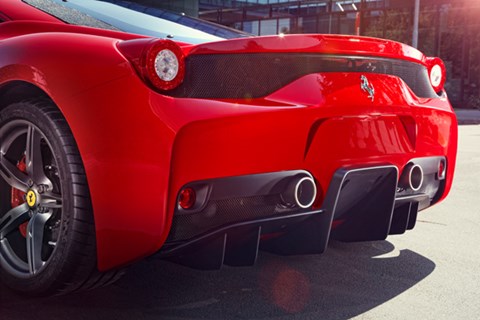
There are intricate aero devices at the rear of the Speciale, too. The rear bodywork has been formed into a larger spoiler with a steeper angle of attack; the exhausts are mounted higher, allowing for a deeper and more aggressive diffuser; and in that diffuser are three active aerodynamic flaps. Their default setting is flush with the bodywork, which creates the maximum amount of downforce, but they can open up to an angle of 17 degrees, which disrupts the airflow, stalling the diffuser like the DRS system on a F1 car and reducing speed-sapping, fuel-consuming drag. The tech will transfer to all future Ferraris.

As should the new Side-Slip angle Control (SSC) system – though it’s not on LaFerrari. The 458 Italia is faster with all the safety systems on, Ferrari claims, its F1-Trac traction control and E-Diff3 electronic differential working together to make you as quick as possible, but SSC takes the technology a step further. There are no extra physical components, instead SSC is an algorithm that analyses the slip angle of the Speciale, compares it with a target value, and uses both F1-Trac and E-Diff3 to deliver the highest possible acceleration. According to Ferrari test driver Raffaelle de Simone, in the Italia’s Race mode there’s a small difference between how fast he and an average driver can go, but with SSC in the 458 Speciale that gap has been closed.
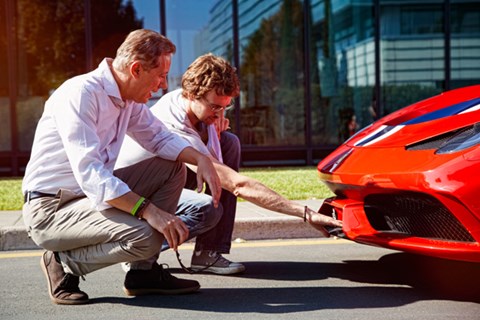
‘Our SSC algorithm controls the car via the slip angle instead of measuring acceleration or speed,’ explains Fedeli. ‘It means the systems adjust more quickly, with more accuracy, and we can forecast what will happen next. This means performance is improved, and if you can permit a certain amount of slip angle, you can drive the car on the throttle without turning off all the safety systems. It means someone who is not an expert can drive the car like an expert, and control the understeer and oversteer. It’s hard to explain, but easy to test and feel.’
Guess we’ll have to drive the Speciale to be sure…
Words: Ben Pulman Photography: John Wycherley
This feature first appeared in the October 2013 issue of CAR magazine. To view subscription offers and download back issues, click here